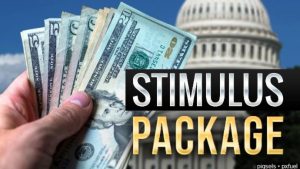
Written by Kelly Anne Smith from Forbes Magazine
COVID-19 continues to wreak havoc on the world’s peoples and economies. In the United States, as businesses shut down or pare back, millions of workers have already been laid off, leaving many to wonder how they’ll pay their bills.
After intense bipartisan negotiations, the House and Senate have finally both passed and President Trump has signed a $2 trillion plus stimulus relief package to help American families and businesses make it through the coronavirus pandemic. The package is the biggest economic rescue package in modern American history. “This is a wartime level of investment into our nation,” said Senate Majority Leader Mitch McConnell after the two sides agreed to the deal.

The package grants households relief in the form of stimulus checks sent directly to most Americans, expanded unemployment benefits, paid sick leave, temporary student debt relief and more.
Here’s what consumers need to know about the stimulus package. For more coverage of COVID-19 and how it affects your financial health, click here.
One much anticipated provision of the final stimulus bill is the checks that will be sent to most Americans. These one-time payments will be sent to eligible individuals, which means anyone who is a legal resident, is not claimed (or eligible to be claimed) as a dependent on someone else’s tax return and doesn’t earn too much.
American adults will be granted the following one-time payments:
Upper income folks aren’t eligible for the checks; the payments start to phase out for single filers with adjusted gross income above $75,000; married couples filing jointly with AGI above $150,000; and heads of household (that’s a single person with dependents), with AGI above $112,500. Stimulus amounts will be paid out based on 2019 income (or 2018, if an individual hasn’t yet filed their 2019 tax return).
Those who receive Social Security retirement or disability benefits but earn too little to have to file returns, will also receive stimulus checks, based on the information sent to the IRS on 2019 forms SSA-1099 and RRB-1099 . (College students and older teens who are dependent on their parents for more than half their support aren’t eligible for the checks, even if they earn a little money on the side.) Use this calculator to get an idea of how much stimulus money you’ll need.
Read More:
Technically, the checks are a 2020 tax credit. So what if your year-to-year income changes? Suppose you earned too much in 2018 and 2019 to be eligible, but your income dropped with the economy in 2020? In that case, when you file your 2020 taxes in 2021, you’ll be eligible for the payments. It appears that individuals who qualify for the stimulus based on their 2019 returns (or their 2018 returns, if they haven’t yet filed for 2019), yet would not qualify based on their 2020 income, do not need to pay any of the stimulus amount back.
Read More: When You File Your 2019 Tax Return Will Impact Your Stimulus Payment
So when will your stimulus money come? If you’ve used a bank account for direct payments to or refunds from the IRS, your money will be direct-deposited. On Thursday, Treasury Secretary Steven Mnuchin said on CNBC that direct deposits could go out within three weeks. Individuals who don’t have a bank account on file with the IRS will be sent checks in the mail, according to their most recent address on file. That’s likely to take longer.
The new law expands unemployment benefits dramatically, with an additional federal payment boosting normal benefits. Here are the details:
If you’re considering filing for unemployment, there are other provisions experts recommend considering first, like exhausting paid sick leave (which could end up paying you more than unemployment insurance). Keep in mind there are already reports of unemployment offices experiencing an overwhelming number of calls, which might stall the process of enrolling and receiving payments.
The new law expands the family leave provided in the Families First Coronavirus Response Act that President Trump signed into law on March 18. That bill covers workers in businesses with fewer than 500 employees. Those covered by the act can get up to 12 weeks of family leave (with the first two weeks unpaid) if they must stay home with children whose schools and day care centers have closed because of the pandemic.
The expansion allows individuals who were laid off on or after March 1, but then rehired before the end of 2020, access to this family leave. (To be eligible for this leave, they need to have worked in that job 30-60 days before the initial layoff).
The benefit paid to individuals eligible for this family leave is two-thirds of pay, with a maximum of $200 per day, or an aggregate $10,000 per worker. In other words, it can be a maximum of $1,000 per week. (Employers cut the family leave checks and then get reimbursed by the federal government through the IRS.)
Employees (both part-time and full time) will get 80 hours of paid sick leave at full pay, capped at $511 per day, or an aggregate $5,110 per worker, with part-timers receiving a proportionate number of hours. Individuals who are unable to work or telework because they are under medical quarantine or treatment for COVID-19, suspect they have the illness or are ordered to quarantine at home are eligible for the pay.
Additionally, individuals who are staying home to care for someone else who has COVID-19 or is suspected of having it, or who have a child whose school or day care is closed because of coronavirus, are eligible for two-thirds of pay capped at $200 per day, or an aggregate $2,000 per worker.
Borrowers with federally backed mortgage loans—loans under Fannie Mae and Freddie Mac—who are experiencing financial hardship due to COVID-19 can request forbearance on their payments for up to six months. Borrowers must submit a request to their servicer and affirm that they’re experiencing a financial hardship during the crisis. Additionally, no foreclosures or evictions from properties with federally backed mortgages can occur during this period.
During the mortgage forbearance period, interest will still accrue. However, additional fees, penalties or extra interest cannot be added to mortgages.
Renters have some eviction protection, but only if they live in a multifamily building or single family home that has a federally backed mortgage. Landlords cannot evict tenants of these buildings or charge any late fees, penalties or other charges for late rent payments.
The Department of Education implemented student loan relief measures last week. The stimulus package expands those measures, giving protection to borrowers pursuing loan forgiveness programs and those who have defaulted loans.
Read More: What To Do About Your Student Loans During The Coronavirus (COVID-19) Crisis
Normally, individuals who withdraw funds early from retirement accounts early (typically before age 59 1/2) must pay a 10% penalty as well as ordinary income taxes. The stimulus relief package, however, provides that “coronavirus-related” distributions of up to $100,000 will be allowed, without the early withdrawal penalty being applied. The sum withdrawn may be re-contributed to a retirement account within three years, without being subject to the usual annual contribution caps. If it’s not repaid, the withdrawal will be taxed at ordinary income tax rates over a three-year period.
In addition, the limit for retirement plan loans has been temporarily raised from the normal $50,000 to $100,000, while the current rule that loans may not exceed half of a 401(k) participant’s vested account balance has been waived.
Meanwhile, required minimum distributions (RMDs)—which those over 72 must take from traditional IRAs, SEPs and 401(k) accounts (but not from Roth accounts)— have been waived for 2020.
Article Link: https://www.forbes.com/sites/advisor/2020/03/27/your-guide-to-the-federal-stimulus-package/#7073a32e2711